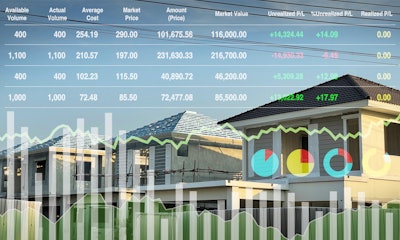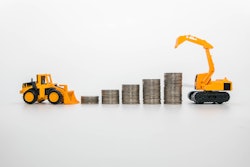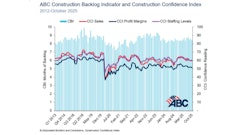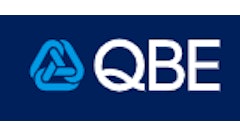
Planning for the future has never been as vital — nor as daunting — as it is today. The past five years have demonstrated just how tumultuous the construction industry can be – from supply chain disruptions and labor shortages to rapid inflation and regulatory shifts, each year seems to bring new and unforeseen changes. Many economic projection models that have thus far been ‘good enough’ are simply no longer able to accommodate the markets they monitor.
Many construction businesses have therefore been galvanized into reconsidering the ways they make their economic projections. But where to begin? Fortunately, building a projection model that can adapt to the market and produce actionable insights comes down to just a few fundamental principles. The four rules that follow provide the basic foundation that a construction business will need to plan, compile and utilize such a model.
1. Use Rate-of-Change to Identify Leading Indicators
A good forecast relies on a thorough understanding of how business performance aligns with the economic trends that surround it. Once they have a better understanding, a business can rely on leading indicators — data points that move ahead of the metric they mirror — to project key trends. But not all leading indicators are created equal.
Identifying the indicators that are most useful begins with selecting the right datasets. These should include both well-monitored internal metrics — like sales, bookings, estimates or project starts — and accessible external indicators — like the Architecture Billings Index (AIA), housing stats from the Census Bureau or national interest rates. The result is a ready pool of metrics where correlations can be drawn. It is worth noting that leading indicators can be either internal or external so long as they are ahead of the trend with which they correlate.
The crucial last step is applying rate-of-change analysis. This method compares the changes in metrics over a specific time period instead of raw values, filtering out much of the short-term noise while highlighting the inflection points that mark the incline or decline of a trend. A construction company can then identify, for example, that architecture billings rise three to six months before a sales increase and incorporate that rule into their forecast model.
2. Know How to Respond to the Market
Correlating trends will only get a business so far. The purpose of a projection model at the end of the day is to inform forward-looking strategy, and that requires both selection and interpretation. First, businesses must choose the trends they will be paying attention to. Next, they must convert those trends into strategies that will protect and promote the growth of the business.
The trends that a construction company can choose to monitor fall into two broad categories: general and industry-specific. National inflation projections, interest rate trends, and authoritative outlooks give insight into the broader economic shifts that influence input costs, financing conditions and eventual pricing strategies. Construction-specific signals like housing starts, nonresidential spending, and labor availability, meanwhile, can offer advance warning for supply-chain or capacity concerns.
A projection model should include strategic guidance for responding to these trends as they arise. If the demand is rising, the business may want to purchase new equipment without delay to avoid backlogs before they can become an issue. This extends into long-term strategy as well; businesses should always monitor for markets that indicate new demand — such as data centers, currently — so that they can pivot into emerging growth sectors ahead of the competition.
3. Continually Grow Internal Capacity
Projection models do not run themselves. Even the highest-quality data is pointless without a team that can analyze and apply it in an effective manner. So to enjoy high-quality economic insights, a construction business must first invest in the people and tools that yield them.
The most important components of any system are the people. In smaller companies projections may fall to one person, like the CEO or CFO. Larger companies will often have finance teams or dedicated analysts that can take the lead. In any event, businesses must ensure that someone is always responsible for monitoring, projecting and interpreting trends as they arise. The person or persons who do this analysis should be continually upskilled to refine their capabilities.
It is also worth investing in a few of the many available tools that can aid analysts in their duties. Platforms like Power BI or Tableau can help to compile and visualize basic data, while the purpose-built platforms provided by some economics firms will be better equipped for precise and comprehensive analysis.
4. Adapt the Model to the Market
Economies are mutable, and any projection model that fails to adapt as conditions change will become outdated before it can ever be useful. So, to build a projection model that lasts, construction businesses must anticipate adjustments from the outset and review their system on a regular basis.
On the design level, this means taking a modular approach to inputs and expectations. Leading indicators should be easy to update or change out, while expected correlations should never be hard-coded into the system. Businesses should then set clear rules for when to adjust their model so that outdated or miscalibrated rules are not allowed to mislead strategic decisions. Such rules generally require comparing actual performance with expectations and revisiting the model if, say, revenue dips 10% or more below forecast.
It is very important, however, not to overreact to short-term noise. Not every fluctuation indicates a major unforeseen trend. It is best to ground strategic decisions on long-range business cycles that can see past immediate volatility and identify overarching trends. Even if tariffs have led to a short-term drop in revenue, for instance, a 12-month moving average may show that the business is really in a steep growth stage.
From Uncertainty to Strategy
It is easy to feel as though the construction industry is at the mercy of the economy, sensitive to every interest hike and labor lull. An effective projection model tames that uncertainty — not through rigid prediction of the future, but through intelligent analysis of and preparation for the likeliest contingencies. By laying the ground rules explored here for their own model, construction businesses can build a system to rely on and plan with the confidence it provides.



















